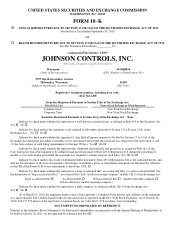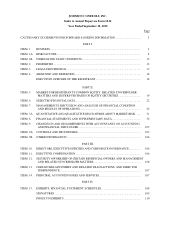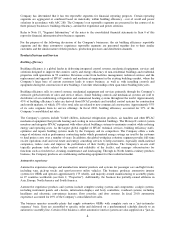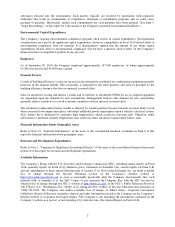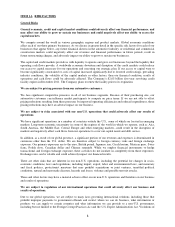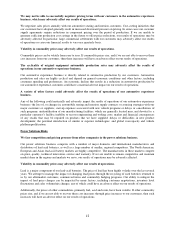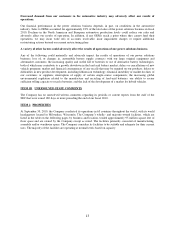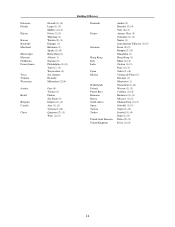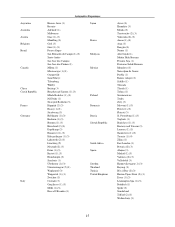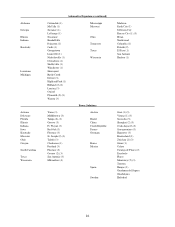Johnson Controls 2010 Annual Report Download - page 6
Download and view the complete annual report
Please find page 6 of the 2010 Johnson Controls annual report below. You can navigate through the pages in the report by either clicking on the pages listed below, or by using the keyword search tool below to find specific information within the annual report.6
Backlog
The Company's backlog relating to the building efficiency business is applicable to its sales of systems and services.
At September 30, 2010, the backlog was $4.7 billion, compared with $4.3 billion as of September 30, 2009. The
increase in backlog was primarily due to market share gains and conditions in the North America systems, North
America service and rest of world markets, partially offset by a decline in Europe. The backlog does not include
amounts associated with contracts in the global workplace solutions business because such contracts are typically
multi-year service awards, nor does it include unitary products. The backlog amount outstanding at any given time is
not necessarily indicative of the amount of revenue to be earned in the upcoming fiscal year.
At September 30, 2010, the Company’s automotive experience backlog of net new incremental business for its
consolidated and unconsolidated subsidiaries to be executed within the next three fiscal years was approximately
$4.0 billion, $1.1 billion of which relates to fiscal 2011. The backlog as of September 30, 2009 was approximately
$2.5 billion. The increase in backlog was primarily due to higher industry production volumes in North America,
Europe and Asia. The automotive backlog is generally subject to a number of risks and uncertainties, such as related
vehicle production volumes, the timing of related production launches and changes in customer development plans.
Raw Materials
Raw materials used by the businesses in connection with their operations, including lead, steel, urethane chemicals,
copper, sulfuric acid and polypropylene, were readily available during the year and the Company expects such
availability to continue. In fiscal 2011, the Company expects increases in steel, copper, chemicals and resin costs.
Lead and other commodity costs are expected to be relatively stable.
Intellectual Property
Generally, the Company seeks statutory protection for strategic or financially important intellectual property
developed in connection with its business. Certain intellectual property, where appropriate, is protected by contracts,
licenses, confidentiality or other agreements.
The Company owns numerous U.S. and non-U.S. patents (and their respective counterparts), the more important of
which cover those technologies and inventions embodied in current products, or which are used in the manufacture
of those products. While the Company believes patents are important to its business operations and in the aggregate
constitute a valuable asset, no single patent, or group of patents, is critical to the success of the business. The
Company, from time to time, grants licenses under its patents and technology and receives licenses under patents
and technology of others.
The Company's trademarks, certain of which are material to its business, are registered or otherwise legally
protected in the U.S. and many non-U.S. countries where products and services of the Company are sold. The
Company, from time to time, becomes involved in trademark licensing transactions.
Most works of authorship produced for the Company, such as computer programs, catalogs and sales literature,
carry appropriate notices indicating the Company's claim to copyright protection under U.S. law and appropriate
international treaties.
Environmental, Health and Safety Matters
Laws addressing the protection of the environment (Environmental Laws) and workers’ safety and health (Worker
Safety Laws) govern the Company’s ongoing global operations. They generally provide for civil and criminal
penalties, as well as injunctive and remedial relief, for noncompliance or require remediation of sites where
Company-related materials have been released into the environment.
The Company has expended substantial resources globally, both financial and managerial, to comply with
Environmental Laws and Worker Safety Laws and maintains procedures designed to foster and ensure compliance.
Certain of the Company's businesses are, or have been, engaged in the handling or use of substances that may
impact workplace health and safety or the environment. The Company is committed to protecting its workers and
the environment against the risks associated with these substances.
The Company's operations and facilities have been, and in the future may become, the subject of formal or informal
enforcement actions or proceedings for noncompliance with such laws or for the remediation of Company-related

